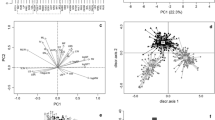Summary
The effect of sample size and species diversity on a variety of similarity indices is explored. Real values of a similarity index must be evaluated relative to the expected maximum value of that index, which is the value obtained for samples randomly drawn from the same universe, with the diversity and sample sizes of the real samples. It is shown that these expected maxima differ from the theoretical maxima, the values obtained for two identical samples, and that the relationship between expected and theoretical maxima depends on sample size and on species diversity in all cases, without exception. In all cases but one (the Morisita index) the expected maxima depend strongly to fairly strongly on sample size and diversity. For some of the more useful indices empirical equations are given to calculate the expected maximum value of the indices to which the observed values can be related at any combination of sample sizes. It is recommended that the Morisita index be used whenever possible to avoid the complex dealings with effects of sample size and diversity; however, when previous logarithmic transformation of the data is required, which often may be the case, the Morisita-Horn or the Renkonen indices are recommended.
Similar content being viewed by others
References
Baroni-Urbani C, Buser MW (1976) Similarity of binary data. Syst Zool 25:251–259
Bray JR, Curtis JT (1957) An ordination of the upland forest communities in southern Wisconsin. Ecol Monogr 27:325–349
Cheetham AH, Hazel JE (1969) Binary (presence-absence) similarity coefficients. J Palaeont 43:1130–1136
Clifford HT, Stephenson W (1975) An introduction to numerical classification. Academic Press, New York-San Francisco-London
Czekanowski J (1913) Zarys Metod Statystycnck. Warsaw: E. Wendego. See also: Coefficient of racial likeness and durchschnittliche Differenz. Anthropol Anz 9:227–249 (1922)
Dice LR (1945) Measures of the amount of ecological association between species. Ecology 26:297–302
Fisher RA, Corbet AS, Williams CB (1943) The relation between the number of species and the number of individuals in a random sample of an animal population. J Anim Ecol 12:42–58
Ghent AW (1963) Kendall's “Tau” coefficient as an index of similarity in comparisons of plant and animal communities. Canad Entomol 95:568–575
Ghent AW (1972) A graphic computation procedure for Kendall's Tau suited to extensive species-density comparisons. Am Midl Nat 87:459–471
Hanski I (1980) Spatial variation in the timing of the seasonal occurrence in coprophagous beetles. Oikos 34:311–321
Horn H (1966) Measurement of “overlap” in comparative ecological studies. Am Nat 100:419–424
Huhta V (1979) Evaluation of different similarity indices as measures of succession in arthropod communities of the forest after clear-cutting. Oecologia (Berl) 41:11–23
Lance GN, Williams WT (1967) Mixed-data classificatory programs. I. Agglomerative systems. Aust Comput J 1:15–20
Mountford MD (1962) An index of similarity and its application to classificatory problems. In: PW Murphy (ed), Progress in Soil Zoology. Butterworths, London, pp. 43–50
Morisita M (1959) Measuring of interspecific association and similarity between communities. Mem Fac Sci Kyushu Univ, Ser E. Bio., 3:65–80
Renkonen O (1938) Statistisch-ökologische Untersuchungen über die terrestische Käferwelt der finnischen Bruchmoore. An Zool Soc Zool-Bot Fenn Vanamo 6:1–231
Sørensen TA (1948) A method of establishing groups of equal amplitude in plant sociology based on similarity of species content, and its application to analyses of the vegetation on Danish commons. K dan Vidensk Selsk Biol Skr 5:1–34
Williams CB (1949) Jaccard's generic coefficient and coefficient of floral community, in relation to the logarithmic series and the index of diversity. Ann Bot 13:53–58
Wolda H (1978) Fluctuations in abundance of tropical insects. Am Nat 112:1017–1045
Wolda H (1981) Seasonality of leafhoppers (Homoptera) on Barro Colorado Island. In: EG Leigh, AS Rand, DM Windsor (eds), Ecology of a tropical forest: Seasonal rhythms and longterm changes. Smithsonian Press, Washington (in press)
Wolda H, Fisk FW (1981) Seasonality of tropical insects II. Blattaria (cockroaches) from the seasonal tropics of Panama. J Anim Ecol (in press)
Author information
Authors and Affiliations
Rights and permissions
About this article
Cite this article
Wolda, H. Similarity indices, sample size and diversity. Oecologia 50, 296–302 (1981). https://doi.org/10.1007/BF00344966
Received:
Issue Date:
DOI: https://doi.org/10.1007/BF00344966




